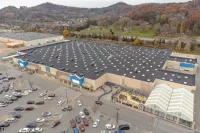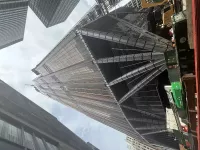Sears, a renowned American department store chain, was established in 1892 as a mail-order catalog company before expanding into retail stores in 1925. Achieving dominance as the largest U.S. retailer by the 1980s, Sears faced a decline in subsequent years, leading to its acquisition by Kmart's management in 2005. The merger resulted in the formation of Sears Holdings. Despite its former glory, Sears filed for bankruptcy in 2018, marking a significant downturn for the once-retail giant. Following the bankruptcy auction, a reduced number of Sears stores remained operational.
1906: Sears's Successful IPO
In 1906, Sears's successful initial public offering (IPO) marked a significant milestone as the first major retail IPO in American financial history, indicating the financial maturation of the consumer sector.
1906: Sears Opens Catalog Plant and Merchandise Building Tower
Sears opened its catalog plant and the Sears Merchandise Building Tower in Chicago's West Side in 1906. This marked the beginning of the company's significant expansion, with the building serving as the anchor for a 40-acre complex dedicated to offices, laboratories, and mail-order operations.
1907: Sears's Sales Reach $50 Million
By 1907, under Rosenwald's capable leadership as vice president and treasurer, Sears experienced significant growth, with annual sales reaching approximately $50 million, a testament to the company's effective strategies and expanding market presence.
1908: Rosenwald Becomes President and Chairman
In 1908, due to declining health, Richard Sears resigned from his position as president, leading to Rosenwald's appointment as president and chairman of the board. Rosenwald's assumption of full control marked a turning point in the company's leadership and strategic direction.
1910: Sears Acquires David Bradley Plow Company
In 1910, Sears made a strategic acquisition by purchasing the David Bradley Plow company, a move that would later lead to the manufacturing of riding mowers, chainsaws, tillers, and other equipment at the Bradley, Illinois factory, expanding the company's product offerings and manufacturing capabilities.
1910: Sears' Long-Held Stock Ticker Symbol
Sears had held the single-letter ticker symbol 'S' on the New York Stock Exchange since 1910, showcasing its longstanding presence in the market.
1919: Economic Depression Impacts Sears
From 1919 to 1921, Sears faced significant financial challenges as a severe depression hit the nation's farms. The economic downturn, coupled with farmers overextending their holdings, had a considerable impact on the company's sales and overall stability.
1921: Rosenwald Invests Personal Wealth in Sears
In 1921, in a bold move to rescue Sears from financial turmoil, Rosenwald demonstrated his unwavering commitment by pledging $21 million of his personal wealth to the struggling company. This substantial investment aimed to stabilize Sears's finances and ensure its continued operations.
1922: Sears Regains Financial Stability
By 1922, thanks in part to Rosenwald's significant financial intervention and strategic decisions, Sears successfully navigated the challenging economic climate and regained its financial stability, marking a turning point in its recovery.
1924: Sears Joins Dow Jones Industrial Average
In 1924, Sears's stock, traded under the ticker symbol "S," became a component of the Dow Jones Industrial Average, a testament to the company's growing influence and stability in the market.
1924: Rosenwald Resigns as President
Rosenwald made the decision to step down as president in 1924, marking a transition in leadership for Sears. Despite his resignation as president, Rosenwald remained as chairman of the board.
February 2, 1925: First Sears Store Opens
On February 2, 1925, Sears's first department store, considered an experiment at the time, opened its doors to the public. Located within the North Lawndale Sears, Roebuck and Company Complex in Chicago, the store's success paved the way for the company's expansion into physical retail across the country.
1925: Sears Opens First Department Store
Under Rosenwald's guidance, Sears opened its first department store in 1925, located on land within the Sears, Roebuck, and Company Complex in Chicago. This marked a significant expansion from its mail-order roots and into physical retail.
1931: Sears Establishes Allstate Insurance Company
Marking its diversification beyond retail, Sears founded the Allstate Insurance Company in 1931.
1932: Rosenwald's Death
In 1932, Julius Rosenwald, a pivotal figure in Sears's history, passed away. Having played a crucial role in the company's growth and transformation, his death marked the end of an era for Sears.
1933: First "Sears Wishbook" Published
Sears introduced its first "Sears Wishbook" Christmas catalog in 1933, a separate publication from the annual Christmas Catalog specifically featuring toys and gifts, capturing the magic of holiday shopping for children and families.
1934: Allstate Integration into Sears Stores
In 1934, Sears strategically integrated Allstate Insurance representatives into its stores, expanding Allstate's reach and providing additional services to Sears customers.
1939: Sears Opens First Air-Conditioned, Open Plan Store
In 1939, Sears continued to innovate in retail design with the opening of Sears-Pico in Los Angeles. This store was notable for being fully air-conditioned, "windowless," and featuring an open plan selling floor, a departure from the traditional segmented floor layouts of the time, enhancing the shopping experience for customers.
1942: Sears Opens Store in Havana, Cuba
Sears expanded its international presence in 1942 by opening a small store in Downtown Havana, Cuba, marking the company's foray into the Cuban market.
1947: Sears Opens First Store in Mexico City
In 1947, Sears opened its first store in Mexico City, marking its entry into the Mexican market, which would later lead to the establishment of Sears Mexico.
1959: Sears Forms Homart Development Company
In 1959, as part of its expansion into suburban markets and malls, Sears established the Homart Development Company specifically for mall development projects.
1962: Sears Divests David Bradley Manufacturing
Due to antitrust concerns stemming from the success of Sears' outdoor products, particularly the David Bradley line which outsold competitor John Deere in plows, Sears was forced to sell half of the David Bradley factory in Bradley, Illinois in 1962.
1968: Sears-Roebuck Foundation Sponsors 'Mister Rogers' Neighborhood'
From its premiere in 1968, the Sears-Roebuck Foundation underwrote the PBS television series "Mister Rogers' Neighborhood."
1973: Sears Tower Becomes Corporate Headquarters
In 1973, Sears moved its corporate headquarters to the newly completed Sears Tower, highlighting the company's growth and prominence in the business world.
1974: Sears Tower Completion
Symbolizing its peak, Sears completed the 110-story Sears Tower in Chicago in 1974, which became the world's tallest building at that time.
1981: Sears Acquires Dean Witter and Coldwell Banker
In a move signifying further diversification, Sears acquired Dean Witter and Coldwell Banker in 1981, expanding its reach into financial and real estate services.
1984: Launch of Prodigy Online Service
In 1984, Sears, in a joint venture with IBM, launched Prodigy, an early online service that aimed to provide users with a wide range of information and services.
1985: Introduction of Discover Credit Card
Sears launched its own credit card, Discover, in 1985, further diversifying its financial service offerings.
1988: Sale of Sears Tower
Sears sold the Sears Tower in 1988 after relocating its headquarters. Despite the sale, Sears retained naming rights for the building until 2003.
1990: Walmart Surpasses Sears as Largest Retailer
A significant turning point occurred in 1990 when Walmart overtook Sears to become the largest retailer in the United States, highlighting the growing competition in the retail industry and the challenges Sears faced.
1992: Lawsuit Over Auto Repair Practices
In 1992, Sears faced a lawsuit from the state of California, which accused the company of fraudulent practices related to its auto repair services.
1992: Sears Changes Employee Compensation Structure
In 1992, Sears shifted from an hourly wage based on longevity to a base wage (usually between US$3.50 and US$6 per hour) and commissions ranging from 0.5% to 11%. Sears claimed the new base wage, often constituting a substantial (up to 40%) cut in pay, was done "to be successful in this highly competitive environment."
1992: Sears Reports Record Loss
Sears suffered a major setback in 1992, posting a record loss of $3.9 billion, the largest ever by an American retailer at that time, highlighting the company's financial struggles.
1992: Sears-Roebuck Foundation Ends Sponsorship of 'Mister Rogers' Neighborhood'
The Sears-Roebuck Foundation stopped sponsoring the PBS television series 'Mister Rogers' Neighborhood in 1992.
1993: Discontinuation of Sears Catalog
In 1993, facing declining sales and rising costs, Sears made the significant decision to discontinue its iconic general merchandise catalog, marking the end of an era for the company.
1995: Completion of Sears' Move to Prairie Stone
By 1995, Sears finalized its relocation to the Prairie Stone Business Park in Hoffman Estates, Illinois.
1995: Sears Divests Homart to General Growth Properties
Continuing its divestment strategy, Sears sold its mall building subsidiary, Homart, to General Growth Properties in 1995, further narrowing its focus on core businesses.
1995: Closure of Sears's Mail-Order Catalog Business Base
In 1995, Sears's mail-order catalog business, which had been based in the Sears, Roebuck and Company Complex, ceased operations, marking a significant shift in the company's business model and the end of an era for the iconic catalog.
1995: Craftsman Becomes Title Sponsor of NASCAR Truck Series
Sears, using its Craftsman brand, became the title sponsor of the NASCAR Truck Series when it began in 1995.
1996: Acquisition of Orchard Supply Hardware
In 1996, Sears acquired Orchard Supply Hardware, strengthening its presence in the home improvement market.
1997: Criminal Charges Over Auto Repair Practices
Adding to its legal troubles, Sears faced criminal charges in 1997 related to its auto repair practices.
1997: Launch of The Great Indoors Home Improvement Stores
Expanding further into the home improvement sector, Sears launched a new chain of stores called The Great Indoors in 1997.
1998: Sale of Western Auto to Advance Auto Parts
Sears sold the remnants of its Western Auto subsidiary to Advance Auto Parts in 1998, marking its exit from the automotive parts market.
1999: Sears Removed from Dow Jones Industrial Average
In 1999, Sears's stock was removed from the Dow Jones Industrial Average, indicating a shift in the company's market position and performance.
2003: Launch of Sears Grand Store Concept
In a bid to revitalize its retail offerings, Sears launched a new store concept called Sears Grand in 2003. These larger stores aimed to provide a wider selection of merchandise and a more modern shopping experience.
2003: Sears Tower Naming Rights Expire
Sears' naming rights to the Sears Tower expired in 2003, marking the end of an era for the company and the iconic building.
November 17, 2004: Kmart Acquires Sears
In a significant turn of events, Kmart Holdings Corporation acquired Sears, Roebuck, and Co. for $11 billion on November 17, 2004, leading to the formation of Sears Holdings Corporation.
August 2005: Sale of Sears Canada Credit Card Operations
Sears sold the remaining credit card operations for its Canadian subsidiary, Sears Canada, to JPMorgan Chase in August 2005.
2005: Kmart Store Conversions and Renovations
Following the merger, Sears Holdings Corporation began renovating some Kmart stores, converting them into the Sears Essentials format and later into Sears Grands.
2006: Peak Profits for Sears Holdings Corporation
Sears Holdings Corporation reached its peak profitability in 2006, achieving $1.5 billion in profits.
2006: Sears Obtains Naming Rights to Now Arena
Sears gained the naming rights to the Now Arena, an 11,000-seat multi-purpose family entertainment, cultural and sports center in Hoffman Estates in 2006.
September 2, 2007: Sears Auto Center Sponsors Scott Riggs' Car in Sharp AQUOS 500
Sears Auto Center sponsored the #10 Gillett Evernham Motorsports car of Scott Riggs for the September 2, 2007, running of the Sharp AQUOS 500 at California Speedway. However, Riggs failed to qualify for the event.
October 2007: Sears Cuts Commission Rates for Some Employees
Sears cut commission rates for employees in some departments to between 0.5% and 4% in early October 2007, but it equalized the base wage across all Home Improvement and Electronics departments.
2007: Reintroduction of Holiday Wish Book
In an effort to reconnect with its past and boost holiday sales, Sears reintroduced a smaller version of its iconic Holiday Wish Book in 2007.
2008: Craftsman Ends Sponsorship of NASCAR Truck Series
Craftsman ended its sponsorship of the NASCAR Truck Series in 2008.
2009: Willis Group Obtains Sears Tower Naming Rights
In 2009, the Sears Tower was officially renamed Willis Tower after the London-based insurer Willis Group Holdings, Ltd. secured the building's naming rights as part of a deal to encourage their occupancy.
2009: Sears Cuts Commission on "Base Items" in Electronics Department
Sears cut the electronic department's commission on "base items" to 1% in late 2009.
2010: Sears Ceases Profitability
A critical point in Sears's decline came in 2010 when the company ceased to be profitable, signaling the depth of its operational and financial challenges.
2011: Start of Significant Financial Losses for Sears
Beginning in 2011, Sears embarked on a period of significant financial losses, totaling $10.4 billion by 2016, further underscoring the severity of its challenges.
2011: Sears Cuts Commission Rates on Non-Base Items in Electronics Department
In 2011, commission rates on non-base items were cut by 2% in the electronics department.
2014: Sears' Debt Exceeds Market Capitalization
In 2014, Sears's financial troubles became increasingly apparent as its total debt surpassed its market capitalization, indicating serious concerns about its financial stability and long-term viability.
2014: Sears Sells Assets to Improve Finances
Throughout 2014, Sears engaged in a series of asset sales, including Lands' End and its stake in Sears Canada, in a bid to improve its financial standing and address mounting losses.
2015: Decline in Sears's Store Sales
Sears experienced a significant decline in sales at its stores in the final quarter of 2016, with sales dropping 10.3% compared to the same period in 2015, further indicating the company's struggles to attract customers.
2015: Sears Focuses on Tech-Driven Retail Strategy
Sears underwent significant changes in 2015, selling off key assets like Lands' End and its stake in Sears Canada, to focus on a more tech-driven retail approach, aiming to adapt to changing consumer behaviors and compete more effectively in the evolving retail landscape.
2016: Craftsman Becomes Title Sponsor of World of Outlaws Sprint Car Racing Series
Craftsman became the title sponsor of the World Racing Group's World of Outlaws Sprint car racing series in 2016.
2016: Steven Mnuchin's Involvement with Sears
In 2016, Steven Mnuchin, who was a board member of Sears Holding until that year, was one of three directors of the Pension Benefit Guaranty Corporation. This connection was noted in a Forbes editorial discussing the implications of Lampert's threat to withhold pension payments in 2019.
2016: End of Multi-Year Financial Losses for Sears
Sears's multi-year period of substantial financial losses, amounting to $10.4 billion, came to an end in 2016.
January 2017: Sears's Debt Exceeds Market Value
Sears's financial troubles deepened by January 2017, as its total debt, amounting to $4.2 billion, exceeded its market capitalization, highlighting the severity of its financial situation.
March 21, 2017: Sears' Market Capitalization Falls Below Debt
By March 21, 2017, Sears's financial struggles were evident as its total debt surpassed its market capitalization, signaling serious concerns about the company's future.
October 2017: Sears and Whirlpool End Partnership
In October 2017, Sears and Whirlpool Corporation, who had been in business for 101 years, ended their partnership. The reason was reportedly due to pricing disagreements.
2017: Sears Maintains Commission-Based Compensation for Appliance Department
By 2017, appliances was the only remaining department at Sears where compensation was based entirely on commission. Other departments give a base pay plus commission.
May 2018: Sears Explores Sale of Kenmore
In May 2018, as a way to explore options to potentially sell the Kenmore brand, Sears announced the formation of a "special committee."
September 24, 2018: Sears CEO Warns of Impending Crisis
On September 24, 2018, Sears's CEO issued a stark warning that the company was "running out of time" to rescue itself from business failure.
October 15, 2018: Sears Holdings Files for Bankruptcy
On October 15, 2018, struggling with declining sales for several years, Sears's parent company, Sears Holdings, filed for Chapter 11 bankruptcy.
November 23, 2018: Sears Releases List of Stores for Sale
As part of its bankruptcy proceedings, Sears Holdings released a list of 505 stores, including 266 Sears stores, that were put up for sale on November 23, 2018. The remaining stores would hold liquidation sales.
January 16, 2019: Sears Wins Bankruptcy Auction
Sears won its bankruptcy auction on January 16, 2019, leading to a reduced number of stores (425) remaining open, including 223 Sears stores.
February 7, 2019: Bankruptcy Judge Approves Lampert's Plan for Sears
A bankruptcy judge approved a $5.2 billion plan by Sears's chairman and biggest shareholder to keep the business going on February 7, 2019. The approval meant roughly 425 stores, including 223 Sears stores, and 45,000 jobs would be preserved.
March 2019: Sears Ends Life Insurance Benefits for Retirees
In March 2019, Sears ended life insurance benefits for an undisclosed number of its 90,000 retirees. A few months earlier, the company handed out over $25 million in bonuses to executives. This key Sears Retiree Benefit was worth between $5,000 and $15,000 for most of the pool (29,000) of eligible retired employees.
April 2019: Sears Opens New Sears Home & Life Stores
In April 2019, Sears tried a new tactic by opening three new stores. These stores, operating under the name Sears Home & Life, offered a limited selection of merchandise.
May 2019: Eddie Lampert Threatens Pension Payments
In May 2019, Eddie Lampert, former chairman and CEO of Sears Holdings, threatened not to pay the $43 million in pension payments owed to 90,000 former Sears and Kmart employees and retirees. This event highlighted concerns about the financial management and obligations of the company following its bankruptcy.
June 3, 2019: Transform Holdco to Acquire Sears Hometown & Outlet Stores
On June 3, 2019, Transform Holdco announced it would acquire Sears Hometown & Outlet Stores. The deal required Transform Holdco to potentially divest its Sears Outlet division to gain approval.
August 6, 2019: Sears Announces Closure of 26 Stores
Sears announced the closure of 26 stores in August 6, 2019, including its last stores in Alabama and West Virginia, in addition to plans to "accelerate the expansion of our smaller store formats which includes opening additional Home & Life stores and adding several hundred Sears Hometown stores after the Sears Hometown and Outlet transaction closes."
August 31, 2019: Transform to Close Additional Sears Stores
On August 31, 2019, Transform announced that it would close an additional 92 stores, including 15 Sears stores, by the end of 2019.
January 2020: Sears Continues Store Closures
A total of 100 more Sears stores closed by January 2020.
February 2020: Sears Closes 51 Stores
Sears closed 51 stores in February 2020 as part of its ongoing struggle to stay afloat.
2020: Sears Loses Naming Rights to Now Arena
Sears no longer had the naming rights to the Now Arena as of 2020.
September 2021: Sears Announces More Store Closures
By September 2021, only 35 Sears stores remained open. It was also during this month that Sears announced additional store closures, including its last store in New York City.
November 24, 2021: Last Sears Store in New York City Closes
The last Sears store in New York City closed on November 24, 2021, with the potential to be redeveloped.
December 2021: Transformco to Sell Sears Headquarters
In December 2021, Transformco announced plans to sell the 2.3 million-square-foot Sears headquarters in Hoffman Estates, which includes 100 acres of undeveloped land.
2021: Sears Continues Store Closures Throughout 2020 and 2021
More Sears stores continued to close throughout 2020 and 2021, including the final Sears in Maine at The Maine Mall.
January 19, 2022: Sears Closes Remaining Auto Centers in the United States
Sears shut the remaining 15 Sears Auto Centers in the United States on January 19, 2022, with a message on the Sears Auto Center website stating: "Auto Centers have closed for business. We appreciate your patronage over the years. If you have any questions concerning warranty claims, please visit us at Sears Help."
May 2022: Closure of 100 Sears Hometown Stores Announced
In May 2022, it was announced that roughly 100 more Sears Hometown stores, including the last four in Michigan, would close permanently.
December 12, 2022: Sears Hometown Stores Files for Bankruptcy
Sears Authorized Hometown Stores, LLC, and Sears Hometown, Inc. filed for Chapter 11 bankruptcy protection on December 12, 2022.
December 13, 2022: Sears Hometown Files for Bankruptcy
Sears Hometown filed for Chapter 11 bankruptcy on December 13, 2022. It was later revealed that all remaining Sears Hometown stores would be liquidated and permanently closed.
January 2024: Few Remaining Sears Stores Open
As of January 2024, there were 11 full-line Sears stores open in the mainland United States, and one in Puerto Rico. The company's U.S. website, Sears.com, remains active for online purchases.
March 2024: Sears Stores in Palm Beach Gardens and New Jersey Close
The Palm Beach Gardens, FL, Sears store closed by March 2024, and the last New Jersey store closed in March 2024.
July 2024: Sears Begins Liquidation of Stores in Stockton and Union Gap
In July 2024, Sears began to liquidate its store in Stockton, California, with closure expected in August. Later in July, Sears began liquidating another store in Union Gap, Washington.
Mentioned in this timeline

Walmart Inc is a multinational retail corporation operating hypermarkets discount...
California is a U S state on the Pacific Coast...
Puerto Rico is a self-governing Caribbean archipelago and island that...
Venezuela officially the Bolivarian Republic of Venezuela is a country...

JPMorgan Chase Co incorporated in Delaware and headquartered in New...

Christmas is an annual festival celebrated on December th commemorating...
Trending

Dame Emma Thompson is a highly acclaimed English actress and writer with a career spanning over years Her exceptional talent...
8 months ago Milan Defeats Bologna 3-1 with Gimenez's Brace and Pulisic's Goal in Serie A
Katherine Barrett Wilson is an American progressive activist community organizer and writer As the co-founder and executive director of the...

The iPhone e is an affordable smartphone in Apple's iPhone series part of the eighteenth-generation line-up Announced on February it...

6 months ago Robert De Niro's best and worst performances, Netflix movie review and The Intern
Adam Schefter is a prominent American sports writer and reporter best known for his role as an NFL insider at...
Popular

Stranger Things created by the Duffer Brothers is a popular...

XXXTentacion born Jahseh Dwayne Ricardo Onfroy was a controversial yet...

Kelsey Grammer is an accomplished American actor producer and singer...

Candace Owens is an American conservative political commentator and author...
Turning Point USA TPUSA is an American nonprofit organization founded...

Bernie Sanders is a prominent American politician currently serving as...
